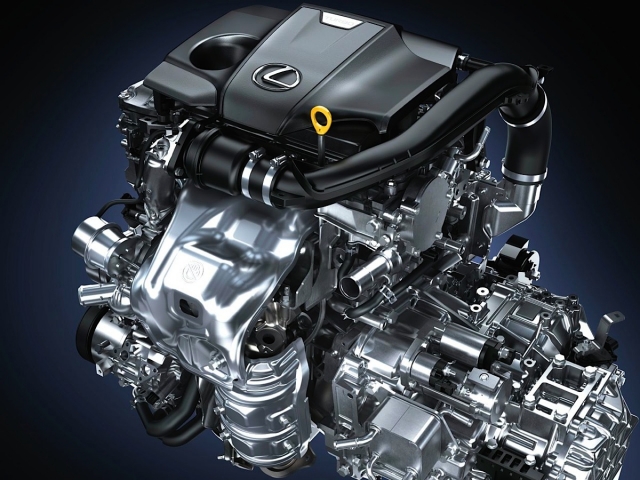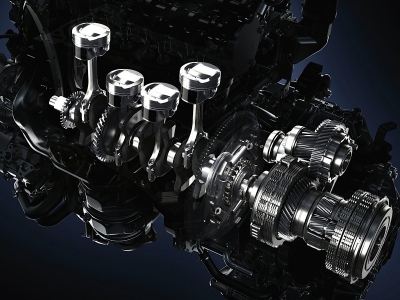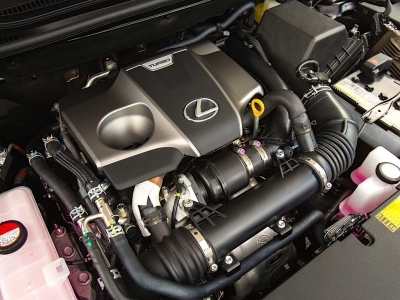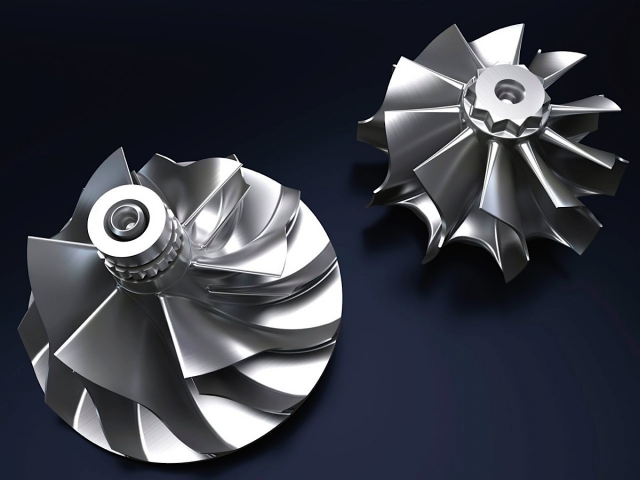 The new Lexus 2.0-liter turbo 4-cylinder will feature an advanced independent variable valve-timing system that allows the engine to move seamlessly between Otto and Atkinson cycles. In addition, there are sophisticated engine-management and turbo controls that maintain a virtually flat torque curve.
The new Lexus 2.0-liter turbo 4-cylinder will feature an advanced independent variable valve-timing system that allows the engine to move seamlessly between Otto and Atkinson cycles. In addition, there are sophisticated engine-management and turbo controls that maintain a virtually flat torque curve.
Powering the upcoming 2015 Lexus NX 200t, the engine marks Toyota’s return to turbocharging after focusing considerable development resources in the past two decades on hybrid powertrains, which included mating Atkinson-cycle engines with electric motors. The last US Toyota-based turbo engines were the 2JZ-GTE twin-turbo straight-6 in the Supra and the 3S-GTE in the Celica Turbo All-Trac — both available in the late ‘90s.
 The new Lexus engine is code-named 8AR-FTS, signaling it’s the 8th iteration of the AR 4-cylinder family. Bore and stroke for this version is a square 3.4 x 3.4 inch (123 ci). While many of the cylinder block’s dimensions and footprints are identical to other engines from the AR platform, the cylinder head is completely different to support both direct and port injection as well as the twin-scroll turbo.
The new Lexus engine is code-named 8AR-FTS, signaling it’s the 8th iteration of the AR 4-cylinder family. Bore and stroke for this version is a square 3.4 x 3.4 inch (123 ci). While many of the cylinder block’s dimensions and footprints are identical to other engines from the AR platform, the cylinder head is completely different to support both direct and port injection as well as the twin-scroll turbo.
“The exhaust manifold is integrated into the head,” explains Paul Williamsen, global manager of education and training for Lexus International. “The turbo bolts directly to the side of the head to shorten the distance between the exhaust valve and turbine vanes.”
Lexus doesn’t just dump all four exhaust pulses into a common manifold; rather, cylinders 1-4 and 2-3 are paired and directed into respective inlets on the twin-scroll turbo.
“We’re driving the impeller at two points,” says Williamsen. “This allows us to control the flow differently on those two ports.”
Flow control is handled with a wastegate on one port to limit boost pressure while the other port has a bypass circuit. When backing off the throttle, the exhaust gas speed drops quickly. If those slow moving gasses continued on to the turbo, then the turbine wheel would slow down.
“We used this bypass on our last production Celica so we could keep the turbos spinning rather than decelerating when exhaust gas velocity drops,” says Williamsen.
The engine’s dual-overhead camshafts can be phased independently over a wide range of crank angle (called VVT-iW), which allows the 8AS-FTS the option of morphing between the Otto and Atkinson cycles.
“In Otto, the valve timing is symmetrical over top-dead-center,” explains Williamsen. “What defines Atkinson is a significant asymmetrical cycle. The compression and expansion ratios are not the same.”
 When the engine is in Atkinson cycle, the intake valve timing is phased or retarded so that the valve closes much later in the compression stroke — which effectively lowers the dynamic compression ratio. That’s because the piston has pushed a portion of the incoming air-fuel charge back through the intake port while the intake valve is open, instead of compressing it against a closed valve, thereby reducing the “pumping losses” or energy needed on the compression stroke.
When the engine is in Atkinson cycle, the intake valve timing is phased or retarded so that the valve closes much later in the compression stroke — which effectively lowers the dynamic compression ratio. That’s because the piston has pushed a portion of the incoming air-fuel charge back through the intake port while the intake valve is open, instead of compressing it against a closed valve, thereby reducing the “pumping losses” or energy needed on the compression stroke.
“So now you have a higher expansion ratio for more efficiency and yet low compression ratio to reduce friction and parasitic losses,” says Williamsen. “The downside is that an Atkinson has a limited rpm range, so typically they haven’t been well-suited for vehicles. The only way to make an Atkinson work in the past was to add a clutched supercharger, like Mazda did with the Millenia. Technically, if it’s got a supercharger, it’s called a Miller cycle.”
Another way to support an Atkinson-cycle engine is with electrical energy, as is found in a hybrid car. For the new NX, however, Lexus engineers leverged Toyota’s experience with VVT and turbos to design a new turbo and intercooler system that allows the engine to move seamlessly between Otto and Atkinson cycles — taking advantage of the Atkinson efficiencies when boost isn’t required.
“Situations where Atkinson is ideal might be part throttle or light throttle, steady speed cruising,” says Williamsen.
The intercooler is fed with a dedicated coolant supply — it does not share coolant with the engine — and is bolted to the back of the engine to reduce plumbing. Max boost for the 8AR-FTS is around 17 pounds.
“We were able to completely engineer this turbo and engine from the ground up as a unit, not have to find something off the shelf and then make it work,” adds Williamsen.
Fuel delivery is with a unique fusion of direct and port injection code-named D4S by Toyota. The combination isn’t a reflection of the direct injectors not being able to supply enough fuel — as is the case with some racing engines on E85 — but rather it’s to ensure proper atomization.
“In larger displacement engines, we find we can get good fuel mixing using pure direct injection,” explains Williamsen. “When cylinder volumes get down around 500cc per cylinder, we find we can get better emissions and stratification of the charge by combining port and direct injection.”
The engine is rated at 235 horsepower at 5,600 rpm with peak torque of 258 lb-ft at 4,000 rpm. The “torque demand control logic” in the engine management computer manipulates the turbo boost so precisely in coordination with the fuel delivery and valve timing that the engine delivers a consistent torque curve.
“Basically, the torque curve is completely flat from 1,650 to 4,000 rpm,” boasts Williamsen. “What that means is the power curve is literally straight up. No wiggles, no bumps, no dips.”






















